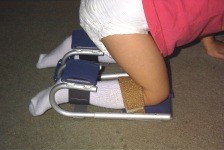BOTOX
Children with cerebral palsy (CP) often have difficulty with walking. This is caused by spasticity, or muscle tightness in the legs. The spasticity may interfere with important activities at home, at school, and in the community. Botulinum Toxin (Botox) is a natural substance that can be injected into the muscles to decrease spasticity. It does not paralyze the muscle. Botox affects only the muscles where it is injected. The reduction in strength and spasticity is temporary. In most patients it lasts between 3 and 6 months.
KNEE SKIS


These are available through the Theradapt catalog.
EPILEPSY
Epilepsy is a conditon of the central nervous system, characterzed by the tendency to have seizures. The term epilepsy covers a wide variety of disturbances in consciousness, ranging from mild sensatonsor interruptions in normal thought, feeling or behavior, which are barely noticeable, to the more severe convulsive seizure. Anyone at any age can get epilepsy, although most cases are diagnosed early in life.
Epilepsy is not a disease, it is not contagious, nor is it a form of mental illness or impaired development. Epilepsy generally does not affect a persons intelligence, creativity or ability. In fact, history records the names of famous individuals who had epilepsy. They include: Julius Caesar, Alexander the Great, Agatha Christie, Joan of Arc, Charles Dickens, Alfred Nobel, Napoleon Bonaparte, and others. In referring to a person who has epilepsy, it is important not to label that person. A person is always a person first, with likes, dislikes, talents and abilities, and above all, feelings. Therefore in making reference to someone who has epilepsy, remember, there is no such thing as an epileptic! There are however, some people who have epilepsy.
Epilepsy is something a person has, not what a person is.
CAUSES OF EPILEPSY
In many cases, a specific cause for epilepsy cannot be found, but known causes include: Head injuries, pre-birth trauma, chemical imbalances, certain infections of the brain, such as encephalitis and meningitis, strokes, and brain tumors. Epilepsy is not generally inherited, although if both parents have a strong family history of epilepsy, the chances that their children will inherit a tendency to have seizures is increased.
WHAT IS A SEIZURE?
A seizure is a temporary generation of excess electrochemical energy inside the brain cells - sometimes described as a lightening storm of the brain. For most people, seizures are brief and infrequent, and do not prevent them from leading healthy, active lives. There are many different types of seizures ranging from convulsive seizures to brief periods where the person appears to daydream.
MICROCEPHALY
The term microcephaly means "small head". This condition is caused by the brain not growing properly. Microcephaly may be present at birth (congenital) or it may develop in the first few years of life (acquired). The effects of microcephaly may vary between mild developmental delay to severe cases of cerebral palsy, epilepsy, visual impairment or feeding difficulties. Often, microcephaly is a characteristic of a syndrome such as Angelman's Syndrome. It can also be a result of prenatal infections such as rubella (German measles), toxoplasmosis (a parasitic infection), cytomegalovirus (CMV) and genital herpes. Some other causes can be exposure to radiation or severe alcohol or drug abuse by the mother, meningitis, fetal stroke, oxygen starvation at birth or a head injury causing brain damage.
Camryn suffers from AQUIRED microcephaly. Her head size was normal at birth. Because she was lacking oxygen at birth, her brain became damaged at that point. Therefore, causing her brain to not grow properly from the time of her birth.